|


| |
Sawasdee
and
welcome to Thailand
|
|
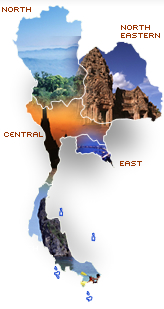
|

|
A portrait of Thailand

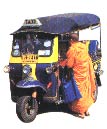 Set within a lush tropical
landscape, Thailand is a theatre of cultural and sensual contrasts for the
visitor. The long, rich heritage and abundant natural resources of this
proud Buddhist nation jostle for space within the dynamism of a country
undergoing rapid industrialization. In turns zestful and tranquil,
resplendent and subtle, Thailand is always compelling. Set within a lush tropical
landscape, Thailand is a theatre of cultural and sensual contrasts for the
visitor. The long, rich heritage and abundant natural resources of this
proud Buddhist nation jostle for space within the dynamism of a country
undergoing rapid industrialization. In turns zestful and tranquil,
resplendent and subtle, Thailand is always compelling.
Thailand is located in a fertile monsoon belt midway between India and
China, the two civilizations that have moulded Southeast Asia. But the
This have long delighted in their distinctive culture. For instance,
though the Tai (rather than Thai) ethnic group probably originated in
Southern China sometime in the first millennium AD, their tonal language
is quite unlike any form of Chinese. Moreover, the elegant Thai script,
though derived from that of ancient Southern India, is distinct.
 Today, Thailand is a member
of the Association of Southeast Asian Nations (ASEAN), though Thais still
take pride in a long tradition of independence. Unlike all her immediate
neighbours, Burma (Myanmar), Laos, Cambodia and Malaysia, the country
never fell to a European colonial power. More fundamentally, though, the
Thai sense of identity is allied with Theravada Buddhism and the monarchy.
Both have been dignified institutions since the Sukhothai period
(13th-14th century), an era when the first real Thai kingdom flourished.
Indeed, the colours of the modern Thai flag (thong trai rong) symbolize
the three forces of Buddhism (white), the monarchy (blue) and the nation
(red). Today, Thailand is a member
of the Association of Southeast Asian Nations (ASEAN), though Thais still
take pride in a long tradition of independence. Unlike all her immediate
neighbours, Burma (Myanmar), Laos, Cambodia and Malaysia, the country
never fell to a European colonial power. More fundamentally, though, the
Thai sense of identity is allied with Theravada Buddhism and the monarchy.
Both have been dignified institutions since the Sukhothai period
(13th-14th century), an era when the first real Thai kingdom flourished.
Indeed, the colours of the modern Thai flag (thong trai rong) symbolize
the three forces of Buddhism (white), the monarchy (blue) and the nation
(red).
Today, the great majority of Thailand's 60 million inhabitants regard
themselves as Thai. Hill tribes are the most obvious ethnic minority
groups, but it is the Chinese who form the largest (and most integrated)
group. The various peoples live relatively peaceably nowadays, though in
1939, in a wave of nationalism encouraged by Prime Minister Phibun
Songkram, the country's name was changed from Siam to Prathet Thai
(Thailand), or "land of the peoples and dialects of the Central Plains,
North, Northeast and South. Each region also has its own topographical
identity. The North is an area of forested mountains, where hill-tribe
minorities coexist with mainstream society. In the South, the narrow Kra
Peninsula presents a 2,500 - km (1,500-mile) coast-line with a hilly
interior of rainforests and rubber plantations. Malay-Muslim culture is a
major influence here.

Between these two extremes are the Central Plains, the cradle of Thai
civilizatiion and a fertile, rice-growing region. Near the mouth of the
Chao Phraya River, the capital, Bangkok, sprawls ever further each year.
Though its 200 year-old palatial splendour can still be discerned, the
city is among the world's most congested and polluted.Different again is
Northeast Thailand (also widely known as Isan), the poorest part of the
country occupying the Khorat Plateau, its eastern border with Laos defined
by the Mekhong River. In this semi-arid region traditional farming
communities, many of them Thai-Lao, eke out a subsistence living.
Economic Development

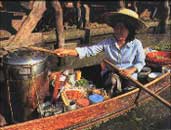
Rice and other agricultural crops were long the mainstays of the Thai
economy, and farming is still regarded with great respect by Thais. From
the mid-1980s, however, a concerted export drive, backed by an attractive
climate for foreign investment, triggered and unprecedented economic boom.
For several years Thailand enjoyed double-digit growth, and, while the
pace slowed in the 1990s, the economy continues to grow at around eight
percent annually as Thailand consolidates its position as one of Asia's
new "tiger" economies. Raw materials top the country's list of imports,
while the leading exports include garments, electrical goods, mechanical
equipment, seafood products, gems and jewellery.
Tourism is now the single largest foreign exchange earner in Thailand. The
country annually hosts more than six million visitors, but the tourist
infrastructure has developed unevenly. Bangkok, Chiang Mai and the beach
resorts attract the vast majority of visitors, and have deluxe hotels
ranking among the world's best. Other regions, such as the Khorat Plateau,
see relatively few visitors and have limited tourist facilities.
Economic success has, unfortunately, been achieved at a price.
Transport infrastructure in particular has lagged behind economic growth,
resulting in Bangkok's notorious traffic chaos. Commerce and
communications are concentrated in Bangkok, putting increasing strain on a
capital with a population of some seven million and rising, while the rest
of the country largely remains rural.

The new wealth remains concentrated in the hands of a few, and if the
rampant poverty associated with some Asian countries is generally absent,
there is nevertheless a widening gulf between the haves and have-nots.
Education is also failing to keep pace with development. Though Thailand
boasts one of the highest literacy rates in Asia, schools and colleges now
face the challenge of producting a generation with the skills needed to
maintain economic growth in the 21st century.
The environment has taken many blows in the last 50 years, during which
forest cover has declined from 70 per cent of the land area to less than
20 per cent. Many animal species have lost their habitats and been hunted
almost to extinction. On the positive side, conservation awareness is
increasing, and measures are being taken to preserve what remains of the
nation's rich natural bounty.
Society and Politics


In spite of the pressures of change, Thai society is relatively stable.
The concept of the extended family is important in Thailand, as in other
parts of Asia. Children live with their parents, often sleeping in the
same room, until marriage. Living alone is rare. Elders are always
accorded respect within families and in society. There is no caste system,
but the social hierarchy, topped by the monarchy , is quite rigid. Social
standing is mainly dictated by wealth and family connections. Women have
less standing than men, despite playing a major role in the economy,
mainly as labourers and white-collar workers.
Hierarchy permeates daily life in many ways. The traditional greeting,
the wai, in which the hands are brought together near the chin, is always
initiated by the inferior, and the height of the wai reflects the social
gap between the parties. If the gap is extreme, inferiors may approach
their superiors on their knees, Other rulers of etiquette, such as never
raising the voice, transcend class. Despite such rules that they apply to
themselves, Thais are renowned for their tolerance of other cultures and
friendliness to visitors. Offence is taken only if there is any perceived
disrespect to the king or Buddhism.
There is no criticism of the king in Thailand's press. Constitutional
since 1932, the monarchy is revered almost as much as when king were
chakravatin, or "lords of life". Kingship and religion are inextricably
linked in Thailand. The present monarch, King Bhumibol Adulyadej (Rama
IX), served as a monk in his youth and presides over some major religious
ceremonies. He is the longest - reining living monarch in the word, having
ascended to the throne in 1946, and has won widespread respect for his
devotion to welfare and environmental projects throughout Thailand.

The monkhood (sangha), some 250,000 strong, plays a crucial social
role. Most teenage boys become monkhood properly later in life and may
choose its austere precepts for life. Monks conduct numerous Buddhist
rites, ranging from festivals to everyday blessings and other social
events. In rural areas, they traditionally play an important role as
school teachers, a profession that in Thailand is perhaps held higher in
regard than anywhere else in the world.
In contrast, politicians are held in far less respect, and the Thai
press makes no hesitation in criticizing the running of the country.
Parliamentary politics are plagued by old - style patronage and privilege
and are still threatened by military coups: There have been 19, mostly
peaceful, coups or attempted coups since 1932. A mass pro - democracy
demonstration in 1992 ended in bloodshed when the army opened fire. A
great tragedy, The event did at least succeed in raising public awareness
and securing a broader base for democratic reform.
Thai Culture and Arts

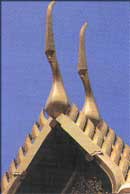
Thailand's classical arts have developed almost exclusively (and
anonymously) in the service of theravada Buddhism. Accordingly, the best
showcase is the wat , where traditional architecture, typified by
sweeping, multi - tiered roofs, countless Buddha images and murals, and
decorative arts, such as woodcarving, stucco relief, gilt, lacquer,
colored glass mosaic and mother - of - pearl inlay, are all usd to
striking effect.
The literary tradition of Thailand is confined mostly to classic tales,
the most important of which is the Ramakien, an ancient moral epic with
its origins in the Indian Ramayana. Such sagas provided the narrative
content for the once - thriving performing arts, best preserved today in
highly stylized classical dance - drama called Khon and lakhon. Thailand's
most notable literary figure is the 19th - century poet Sunthorn phu.
Avant - grade and neo- traditionalist painting is booming while the
film industry thrives on a diet of comedies, thrillers and period dramas.
One very popular novel, The Four Reigns (1953), was written by for mer
prime Minister Kukrit Pramoj. A few files, such as Luk Isan (1978), set in
the Northeast, and number of books tackle social issues.
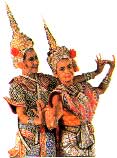 On the sporting front,
Thailand's world - renowned, unique style of kick boxing draws big crowds,
while other traditional pastimes range from takraw, a game not unlike
volleyball, but using the feet, to kite - flying. Numerous colorful
festivals, many linked to both Buddhism and the changing seasons, are
celebrated with exuberance. On the sporting front,
Thailand's world - renowned, unique style of kick boxing draws big crowds,
while other traditional pastimes range from takraw, a game not unlike
volleyball, but using the feet, to kite - flying. Numerous colorful
festivals, many linked to both Buddhism and the changing seasons, are
celebrated with exuberance.
Whatever the activity, Thais believe that life should in all things,
from eating - some thing for which Thais have a passion to simply going
for a stroll with friends.
Click here
to read more about Thailand at GoThailand.com web site........
|
|